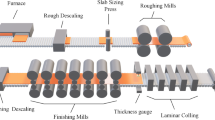Abstract
The shearing line is the key to improve the quality and efficiency of heavy plates. A model of contour recognition and intelligent shearing strategy for the heavy plate was proposed. Firstly, multi-array binocular vision linear cameras were used to complete the image acquisition. Secondly, the total length of the steel plate after cooling was predicted by back propagation neural network algorithm according to the contour data. Finally, using the scanning line and a new camber description method, the shearing strategy including head/tail irregular shape length and rough dividing strategy was calculated. The practical application shows that the model and strategy can effectively solve the problems existing in the shearing process and can effectively improve the yield of steel plates. The maximum error of detection width, length, camber, and the length of the irregular deformation area at the head/tail of the plate are all less than 5 mm. The correlation coefficient of the length prediction model based on the back propagation neural network is very high. The reverse ratio result of edge cutting failure using the proposed rough dividing strategy is 1/401 = 0.2%, which is 2% higher than that by human.















Similar content being viewed by others
References
S.H. Zhang, L. Deng, L.Z. Che, J. Manuf. Process. 75 (2022) 100–109.
X. Chen, Q.W. Cai, B.S. Xie, Y. Yang, Z.Y. Zhao, Steel Res. Int. 89 (2018) 1800409.
F. Schausberger, A. Steinboeck, A. Kugi, IEEE Tran. Control Syst. Technol. 26 (2017) 842–856.
X.M. He, T.X. Zhao, F. Shen, Q. Liu, Y. Fang, Q.H. Hu, Biosyst. Eng. 201 (2021) 1–10.
K. Li, X. Wang, L. Ji, in: 2019 International Conference on Artificial Intelligence and Advanced Manufacturing, Dublin, Ireland, 2019, pp. 19264717.
J.G. Ding, G.Q. Wang, Y. He, L. Kong, Z. Zhao, Steel Res. Int. 91 (2020) 1900345.
A. Bahrami, M.K. Khouzani, S. Mokhtari, S. Zareh, M. Mehr, Metals 9 (2019) 801.
Y. Sun, Y. An, in: 2009 International Conference on Test and Measurement, Hong Kong, China, 2009, pp. 161–164.
M. Kim, W. Lee, J. Yoo, P. Park, in: 2015 15th International Conference on Control, Automation and Systems, Busan, Korea (South), 2015, 15680799.
N. Kong, J. Yoo, J. Lee, S. Yun, J. Nae, P. Park, Optical Eng. 50 (2011) 43–56.
C. Fraga, R. Gonzalez, J. Cancelas, L. Enguita, L. Loredo, in: Conference Record of the 2004 IEEE Industry Applications Conference, 39th IAS Annual Meeting, Seattle, USA, 2004, 8213390.
Y. Yang, C. Chen, C. Ho, W. Li, J. Wu, in: 2008 IEEE Industry Applications Society Annual Meeting, IEEE, Edmonton, Canada, 2008, 10323104.
J. Ding, Y. He, L. Kong, W. Peng, ISIJ Int. 61 (2021) 2540–2551.
A. Kumar, S. Rath, M. Kumar, Materials Today: Proceedings 42 (2021) 650–659.
A. Gerasimova, O. Mishedchenko, V. Devyatiarova, IOP Conf. Ser.: Mater. Sci. Eng. 709 (2020) 022016.
G. Wang, K. Qian, Acta Opt. Sin. 40 (2020) 181–193.
J. Ruan, L. Zhang, S. Gu, W. He, S. Chen, Ironmak. Steelmak. 41 (2014) 199–205.
B. Wang, Z. Wang, B. Wang, G. Wang, R. Misra, Metall. Mater. Trans. A 46 (2015) 2834–2843.
Z. Zhou, Machine learning, Tsinghua University Press, Beijing, China, 2018.
Z.Y. Dong, W.M. Xu, J. Xu, H. Zhuang, IOP Conf. Ser.: Earth Environ. Sci. 310 (2019) 022036.
Z. Dong, X. Li, F. Luan, D. Zhang, J. Manuf. Process. 77 (2022) 282–300.
X. Han, Z. Wei, B. Zhang, Y. Li, T. Du, H. Chen, Journal of Hydrology 596 (2021) 126104.
Acknowledgements
The paper was prepared under the support of the Natural Science Foundation of Liaoning Province (Grant No. 2022-MS-277). This research was also financially supported by the Youth Project of Foundation of Liaoning Province Education Administration (Grant No. lnqn202016).
Author information
Authors and Affiliations
Corresponding author
Ethics declarations
Conflict of interest
The authors declare no conflict of interest.
Rights and permissions
Springer Nature or its licensor (e.g. a society or other partner) holds exclusive rights to this article under a publishing agreement with the author(s) or other rightsholder(s); author self-archiving of the accepted manuscript version of this article is solely governed by the terms of such publishing agreement and applicable law.
About this article
Cite this article
Cao, Jz., Wang, Yx., Huang, Sw. et al. Optimized shearing strategy for heavy plate based on contour recognition. J. Iron Steel Res. Int. 30, 1821–1833 (2023). https://doi.org/10.1007/s42243-023-00936-2
Received:
Revised:
Accepted:
Published:
Issue Date:
DOI: https://doi.org/10.1007/s42243-023-00936-2




